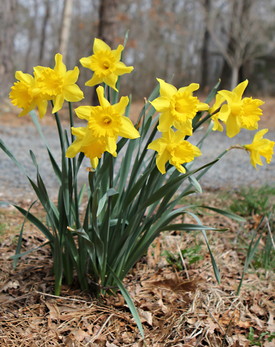 The cool breezes of fall waft through the windows, a welcome treat after the heat and humidity of summer. There is a theory that these breezes bring the odor of the pine forests of Canada rather than the dust and swamps of the hot southlands. The jet stream is moving north as it heralds the coming winter, bringing cooler air with a fragrance of pine terpenes.
The cool breezes of fall waft through the windows, a welcome treat after the heat and humidity of summer. There is a theory that these breezes bring the odor of the pine forests of Canada rather than the dust and swamps of the hot southlands. The jet stream is moving north as it heralds the coming winter, bringing cooler air with a fragrance of pine terpenes.
Ecology and gardening are both season-controlled. Or to be more scientific, temperature-mediated. And each ecological sequence has its work chores. In fall, its planting, pruning, clean up, seeding, fertilizing, winterizing, etc. until mental fatigue sets in before you even start.
But the most happy chore is bulb planting. Did you have lovely early blue Scilla peeping above the ground last spring? If not, consider planting some, but be sure they will bloom where you can see them from a well used window. There is nothing worse than planting bulbs somewhere you can’t see the flowers.
If squirrels and deer have decimated your tulips in the past, consider sticking to poisonous species, like daffodils and narcissus. The deer don’t eat them. Grape hyacinth (muscari) and hyacinths too.
 The secret to keep bulbs blooming for many years is to plant them deep enough. That means at least 3 x their height. For a tall daffodil, that’s at least 9 inches deep. Fertilizer helps. Wood ashes on top of the soil, in fall, is useful though not complete. The Dutch fertilize their bulb fields with 12-10-18. (They do it in spring just after bloom, and in fall, plus smelly manure. But then they’re running a business and want them to mature faster for sale.) White Flower Farm sells 5-10-20.
The secret to keep bulbs blooming for many years is to plant them deep enough. That means at least 3 x their height. For a tall daffodil, that’s at least 9 inches deep. Fertilizer helps. Wood ashes on top of the soil, in fall, is useful though not complete. The Dutch fertilize their bulb fields with 12-10-18. (They do it in spring just after bloom, and in fall, plus smelly manure. But then they’re running a business and want them to mature faster for sale.) White Flower Farm sells 5-10-20.
When you buy bulbs, stick with ones labeled "REPEATER". Most varieties, especially fancy ones and tulips, bloom only for a couple of years. The bulbs tend to split into smaller ones that don’t bloom.
If animals constantly dig in your newly planted beds, consider putting a piece of chicken wire over the plantings. If they chew the shoots in spring, spray with bad tasting ROPEL, or an animal repellant. Spray when they are little new shoots, then again when growing, and again when the tulip buds begin to open. There is nothing more infuriating than seeing a long awaited blossom chewed off and lying on the ground.
The story of Holland’s Tulip Mania bubble in the 1600s is not unlike our own financial system. Bulbs were collected and grown by royalty. They became a national obsession, especially unusual or rare varieties. They were collected and traded like art. Or gambling.
But growing bulbs to blooming size takes time, actually years. Farmers grew them, people borrowed against the crop delivery, exchanged promissory notes. There is a story that a workman ate one and the owner had him jailed.
Prices rose. One bulb could cost 10 times the average yearly income. By 1636, they were traded on the stock exchange. They became a big speculative bubble, until the bottom fell out of the market.
In 1637, prices crashed by 90% in a few months. Some people lost their farms, their life savings. The tulip bubble coincided with Bubonic Plague in Haarlem, which may have influenced things.
However they are still a much loved national flower, and Holland is the major grower of bulbs. One wonders why real gardeners must always have bulbs bloom in spring. They are but a fleeting beauty. But worth a little digging in fall as the pine laced breezes of fall waft around us.
More gardening information can be found on www.mothersgarden.net.
Credit: www.mothersgarden.net




























